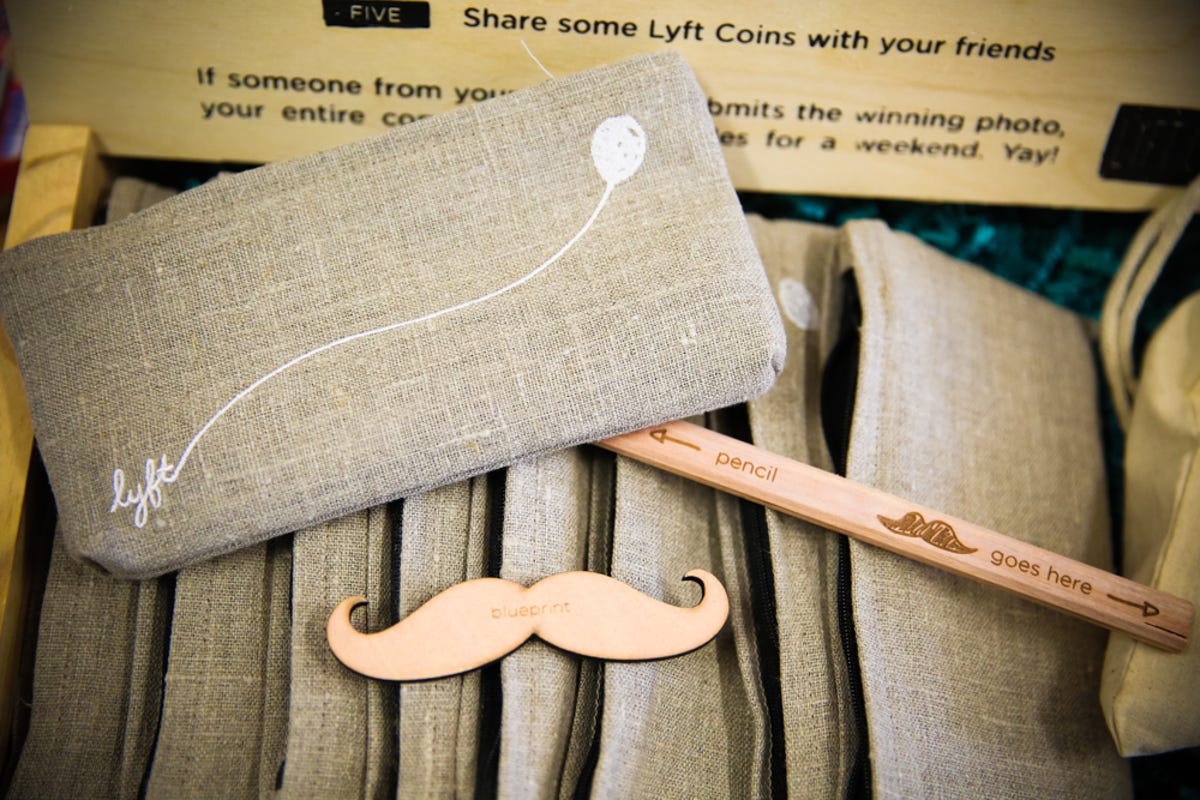Much like how the iPod’s white headphones became a calling card for Apple fans in the early 2000s, the pink mustache — officially called a “Carstache” — has become a symbol that’s taken on a life of its own.
It’s inspired the community to create a persona for their cars, including the DiscoLyft, a vehicle that has an LED mustache to go with the driver’s party-themed car. Drivers will even wear mustache accessories while they drive, or provide them for their passengers. Lyft’s Facebook page is full of mustached fans. Launches in new cities are typically kicked off with a mustache parade.
“They’ve made it more of their symbol and taken it for their inspiration,” Zimmer said. “It’s empowering the community to help us define the experience and the brand, which is so on point for use because we are a peer-to-peer service.”
A stache is born
Zimmer is often questioned about the quirky car ornament. When asked why he and co-founder Green landed on the pink mustache as a branding element, his answer is always the same: Why not?
“We were looking for something to humanize Lyft and delight people,” Zimmer said, making his way through the company’s crowded offices in San Francisco startup-centric SoMa district. “So, obviously a pink mustache.”
Zimmer stopped at a table covered in different colored material and little, beige bags, picked one up and unzipped it. Inside was a mustache making set, complete with a wooden mustache cutout, different colored papers, and a wooden carpenters’ pencil that doubles as a mustache wand. The kit, inspired by the fake mustache wands made by various Lyft’s drivers, is one of Lyft’s new promo tools.


Lyft
The stache’s actual origins are fuzzy, as Zimmer tells it. The pink color may have been left over from when Lyft planned to be an all women’s ride share service (“All of our girlfriends and wives told us it was a dumb idea,” he said), and since mustaches are typically a masculine icon, the founders thought it would be a funny icon.
The small office once held less than 20 employees but is now bursting at the seams — in no small part thanks to what’s in those tiny beige bags.
Despite the company’s undeniable ties to the pink moniker (and the fact that it’s scattered around the office), Zimmer said Lyft doesn’t want to overuse it. It’s no where on Lyft’s app and mainly used by its community of drivers. Zimmer knows that using a fuzzy pink mustache to brand a service is also an open invitation for criticism and can also give Lyft’s competitors a good idea of the size of the Lyft fleet.
“I think that’s another reason we want to use it sparingly. Because over used, it can be too much, we’ve tried to be thoughtful about the use of it, to have it has a fun element but not have it be everything,” he said.
Still, it’s a valuable piece of Lyft’s culture. So valuable that Lyft hired the Carstache creator Ethan Eyler two months ago to work for the company full time. Eyler, who started his Carstache business in 2010, has the official title of “Inventor” at Lyft.
Eyler was driving to work one day when he had the though “wouldn’t it be funny if all these cars had mustaches?”
That did it. He ended up quitting his job to do the stache business full time (“My family thought I was jumping the shark,” he said.) and then Lyft came a-knocking.
“First they ordered 10 pink mustaches and then 25,” he said. “And then, onward.”
More than decoration
Eyler sat inside the office long after most people in the city had gone home for the day. His mission? Find the best material for a pink, fuzzy mustache.


Donna Tam/CNET
The staches are currently made of synthetic fur, but Eyler is trying to come up with an alternative that will make the stache more weather proof so it can combat the likes of cities like rainy Seattle and windy Chicago.
A stack of samples and prototypes (which doubles as a comfy bed for Eyler’s dog Walter) sit on the ground next to his desk. One is made of green AstroTurf and another is some other kind of pink, plastic fringe material. Eyler starts talking about the chemical structure of certain plastics, and finding coating for the staches. Zimmer came across the NeverWet video the other day and sent the information to Eyler. The substance is a spray that is suppose to make items completely waterproof without changing the way something looks or feels.
“I just ordered a whole case to try it out,” Eyler said excitedly.
While it may seem like silly decoration, the stache has turned the year-old service into an icon of disruption in the transportation industry like no other service.
Related stories
- FTC Takes Aim at Companies Deceiving and Exploiting Gig Workers
- Uber, Lyft Drop Mask Mandate, Judge Orders Amazon to Reinstate Fired Employee
- The 50 Best Alexa Skills That Help Make Your Life Much Easier
Taxi drivers curse the mustachioed cars as they pick up passengers in front of their eyes and tell anyone they can that drivers aren’t properly licensed or insured (Lyft maintains that they have a $1 million insurance policy to cover its rides). Competitor Uber waged a “Shave the Stache” campaign that encouraged drivers to switch from Lyft to UberX, Uber’s ride sharing service.
But the community of Lyft drivers love the stache and that’s helped the service expand quickly. Valued at $275 million Lyft currently operates in 13 cities, with the last six cities opening in just the last month. It’s given more than a million rides and raised over $82.5 million from investors to date.
Sure, that might not be as much as the $307 million Uber raised, but the stache definitely keeps people talking and Lyft growing.



